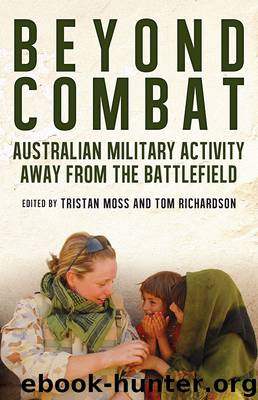Beyond Combat by Tristan Moss

Author:Tristan Moss
Language: eng
Format: epub
Publisher: NewSouth Publishing
10
FROM BULLY BEEF TO CRÈME CARAMEL: FEEDING THE TROOPS
ALISON WISHART
One of the often ignored subjects in military history is the importance of food, water and diet and the links between nutrition, sickness and the ability of the troops to fulfil their military duties. While historians exhaustively analyse strategy and tactics, or the ability of logistics systems to provide ‘combat’ supplies such as fuel and ammunition, it is food (along with clothing and shelter one of the three basic requirements for human survival) that is often overlooked or only superficially analysed.1 In a war zone, soldier survival is paramount, and what they eat and drink will have an impact on their physical and psychological health. The importance of food to the Australian and New Zealand soldiers fighting the Gallipoli campaign in 1915 saw radical changes to army food during the Second World War, and the way food was provided at the mess and as portable rations at Multinational Base Tarin Kot (MBTK) in Afghanistan in 2014 is a focus.
Nutrition was considered a ‘new knowledge’ in 1915.2 However, by the time of the Great War the role of ‘vitamines’ – a term provided by Polish biochemist Casimir Funk in preventing deficiency diseases such as scurvy, pellagra and rickets – was becoming more widely known, particularly through the published research of Cambridge scientist Frederick Gowland Hopkins.3 Mikulas Teich has argued that ‘vitamines’ were still considered ‘accessory substances’ to a diet based on proteins, carbohydrates, fats and salts.4 German nutrition scientists believed that the army required a high protein diet. It was a belief that, some researchers argue, contributed to Germany’s ultimate defeat, as the emphasis on protein for the front contributed to the food shortages that led to collapse in support for the war effort in 1918.5 Teich also underscores the importance and acute difficulties of supplying both civilian and army populations with the first munition of war – food. He observed, as does Jay Winter, that between 1915 and 1918, while the English working classes increased their consumption of fresh fruit, and plots for growing vegetables increased by 250 per cent, soldiers’ rations remained largely devoid of fresh fruit and vegetables.6 The modern-day food pyramid outlining that a healthy diet contains one third fruit and vegetables, had not been developed in 1915.
Download
This site does not store any files on its server. We only index and link to content provided by other sites. Please contact the content providers to delete copyright contents if any and email us, we'll remove relevant links or contents immediately.
| Africa | Americas |
| Arctic & Antarctica | Asia |
| Australia & Oceania | Europe |
| Middle East | Russia |
| United States | World |
| Ancient Civilizations | Military |
| Historical Study & Educational Resources |
The Memory Code by Lynne Kelly(2286)
Schindler's Ark by Thomas Keneally(1764)
Kings Cross by Louis Nowra(1683)
Burke and Wills: The triumph and tragedy of Australia's most famous explorers by Peter Fitzsimons(1313)
The Falklands War by Martin Middlebrook(1298)
1914 by Paul Ham(1274)
Code Breakers by Craig Collie(1185)
Paradise in Chains by Diana Preston(1181)
Burke and Wills by Peter FitzSimons(1175)
Watkin Tench's 1788 by Flannery Tim; Tench Watkin;(1170)
A Farewell to Ice: A Report from the Arctic by Peter Wadhams(1160)
The Secret Cold War by John Blaxland(1155)
The Protest Years by John Blaxland(1121)
30 Days in Sydney by Peter Carey(1084)
The Lucky Country by Donald Horne(1077)
Lucky 666 by Bob Drury & Tom Clavin(1069)
THE LUMINARIES by Eleanor Catton(1067)
The Land Before Avocado by Richard Glover(1047)
Not Just Black and White by Lesley Williams(1018)
